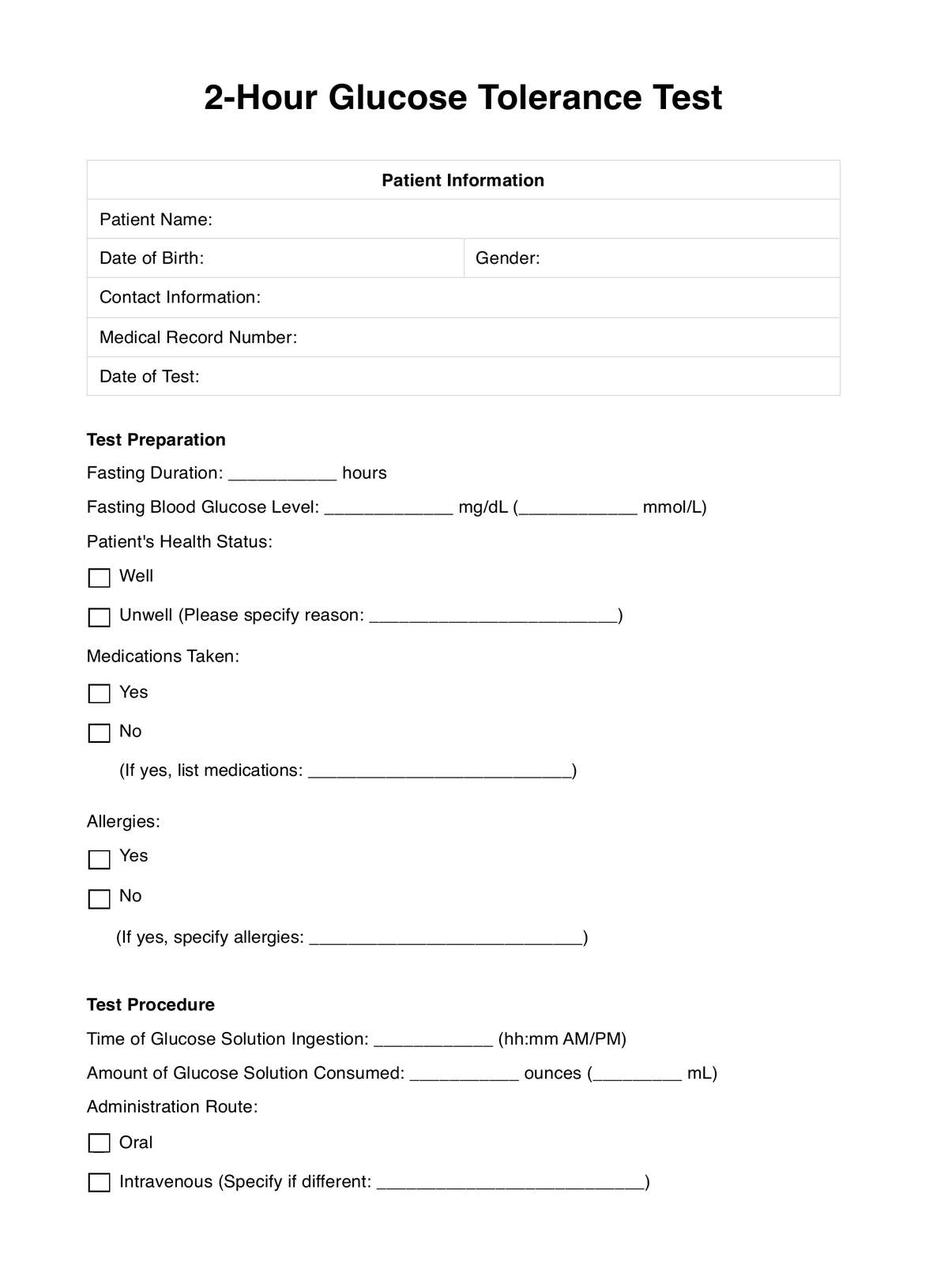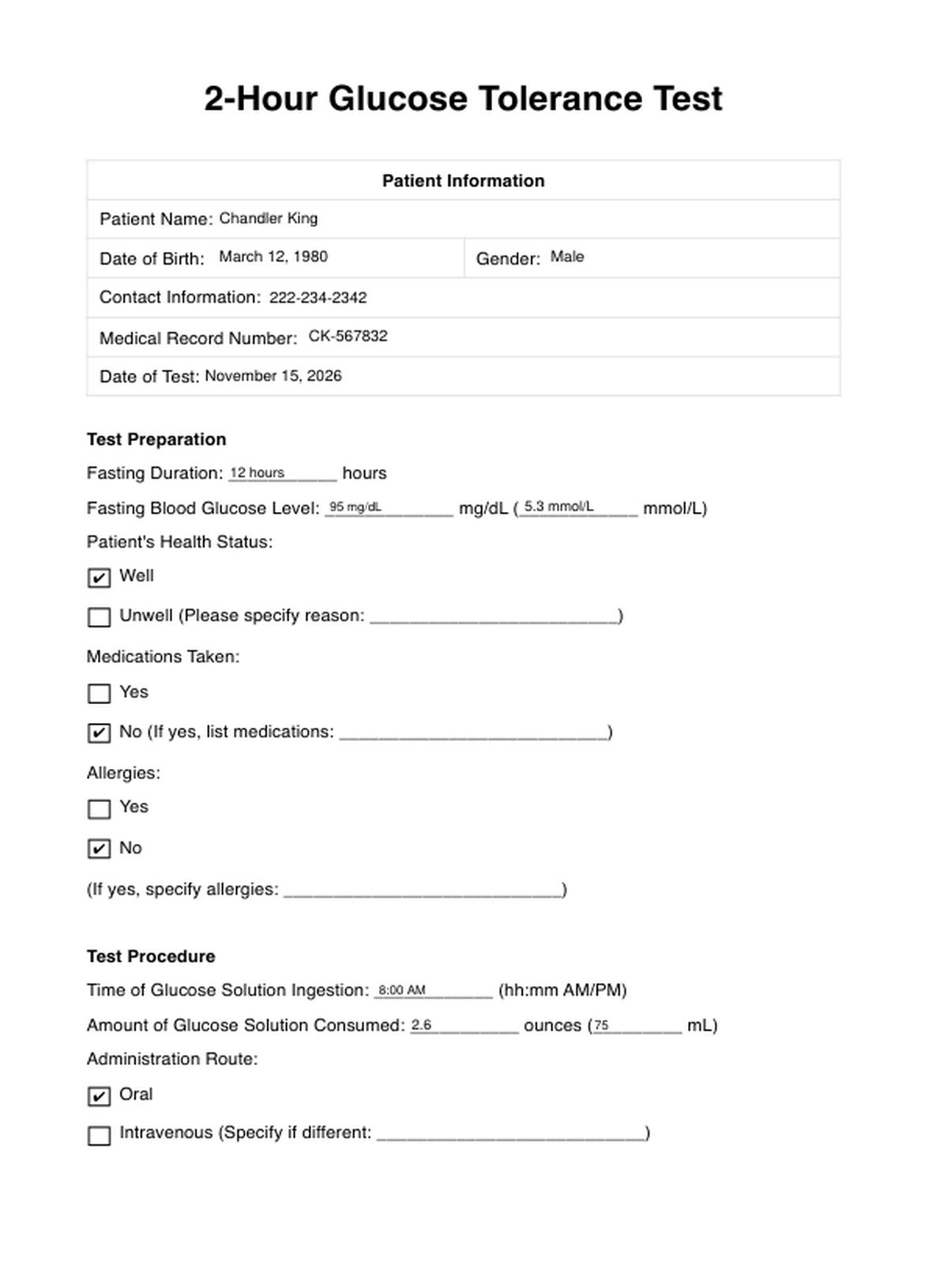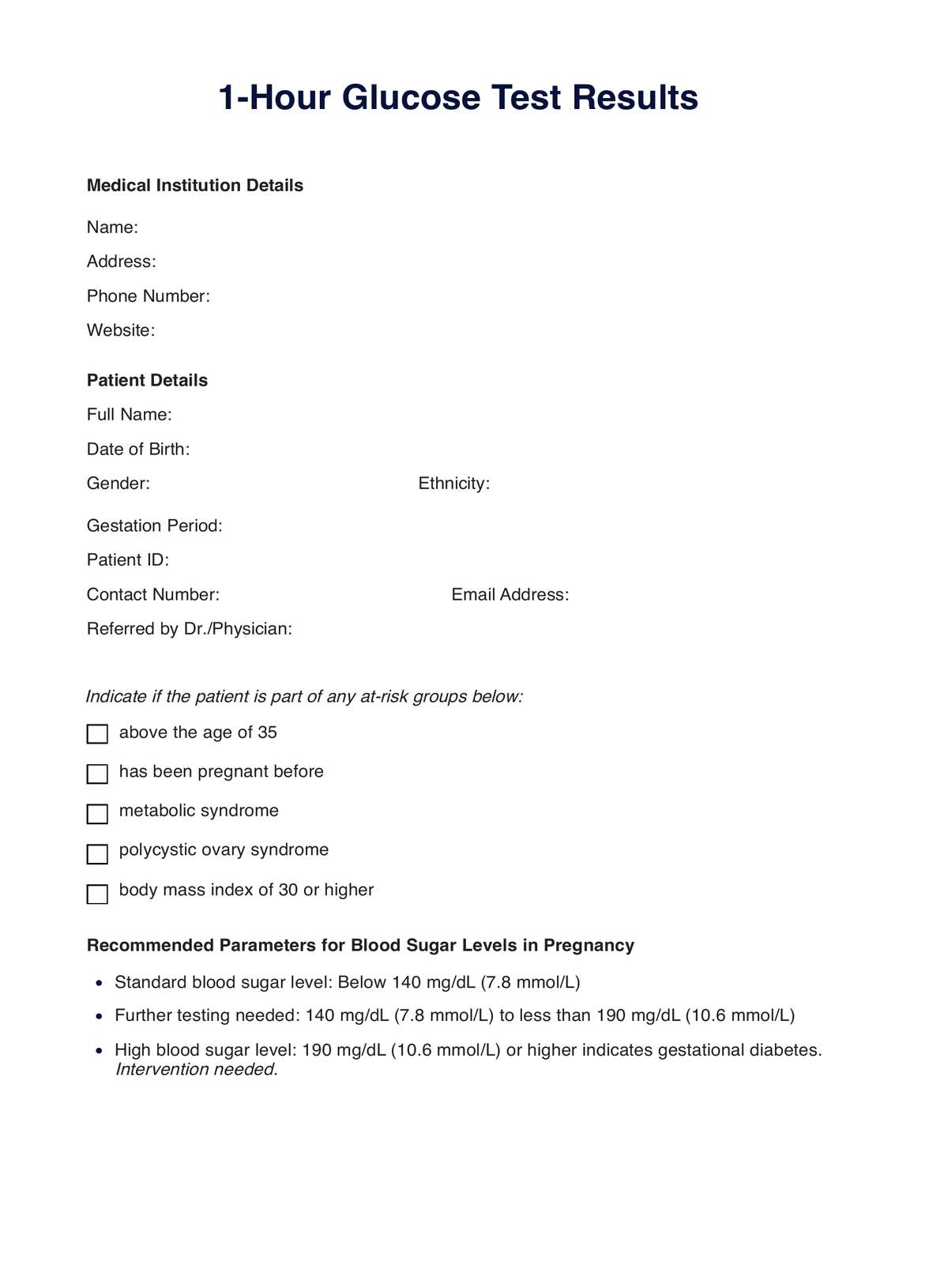2 Hour Glucose Tolerance
Need a 2 Hour Glucose Tolerance Test? Find the essential form for accurate results. Get it now to streamline diagnosis and care. Optimize healthcare today!


What Is A 2 Hour Glucose Tolerance Test?
A 2-Hour Glucose Tolerance Test is a diagnostic medical procedure used to evaluate how the body processes glucose after consuming a sugary solution. This test is vital for assessing glucose metabolism and is primarily employed in diagnosing prediabetes, diabetes, and gestational diabetes.
Healthcare providers typically recommend this test to individuals who exhibit symptoms of diabetes or those at higher risk due to factors like obesity, a family history of diabetes, or a history of gestational diabetes.
The 2 Hour Glucose Tolerance Test form is designed to facilitate the documentation of the test results. It is a structured tool for healthcare professionals to record essential patient information, fasting blood glucose levels, details about the glucose solution ingested, and the crucial 2-hour blood glucose measurement.
This form includes sections for interpreting the results and recommendations for further actions. It's a comprehensive and organized approach to ensure that all relevant details are accurately captured during the test, making it an invaluable aid in the diagnostic process and the subsequent management of diabetes-related conditions.
2 Hour Glucose Tolerance Template
2 Hour Glucose Tolerance Example
How Does It Work?
Using the Printable 2 Hour Glucose Tolerance Test Form is essential for healthcare professionals to conduct and document the test results efficiently. Here are five key steps on how to use the form:
Step 1: Patient Identification
Begin by filling in the patient's details, including their name, date of birth, gender, and medical record number. Ensure the form is dated, and include your contact information as the healthcare provider.
Step 2: Test Preparation
Record important preparatory information. Note the duration of fasting, fasting blood glucose level, the patient's health status, medication usage, and allergies, if any. Ensure that the patient has adequately fasted.
Step 3: Test Procedure
Record the exact time the patient ingests the glucose solution, the amount consumed, and the route of administration (typically oral). This section documents the specifics of the test itself.
Step 4: Blood Glucose Measurements
Document the baseline fasting blood glucose level and the 2-hour blood glucose level. This information is crucial for diagnosing and interpreting the results.
Step 5: Interpretation and Recommendations
Check the appropriate interpretation based on the test results, such as "Normal," "Impaired Glucose Tolerance," or "Diabetes." Provide recommendations based on the findings, such as further testing, specialist referrals, or lifestyle and dietary advice.
When Would You Use This Test?
The 2-Hour Glucose Tolerance Test is an indispensable resource for various healthcare practitioners, particularly those involved in diabetes management and prenatal care. This resource comes into play when diagnosing, monitoring, or managing conditions related to glucose metabolism.
For diabetes specialists, the test is a crucial tool in diagnosing type 2 diabetes, allowing them to assess how a patient's body responds to glucose intake after a meal. It helps identify patients with impaired glucose tolerance or prediabetes, enabling early intervention and lifestyle adjustments to prevent the progression to full-blown diabetes.
In obstetrics and gynecology, the form serves as a cornerstone for prenatal care. Obstetricians and midwives use it to screen for gestational diabetes in pregnant women, ensuring the health of both the mother and the developing baby. It helps determine if expectant mothers need closer monitoring and dietary management during pregnancy.
What Do The Results Mean?
Using the Free 2 Hour Glucose Tolerance Test helps provide valuable insights into a patient's glucose metabolism and can have significant implications for their health. Understanding these results is essential for healthcare professionals and patients alike.
A normal result typically shows that the patient's blood glucose level remains below 140 mg/dL (7.8 mmol/L) two hours after consuming the glucose solution. This indicates that the body is efficiently processing glucose, and there is no immediate concern for diabetes or impaired glucose tolerance.
Impaired Glucose Tolerance (IGT) or prediabetes is indicated when the blood glucose level falls between 140 and 199 mg/dL (7.8 to 11 mmol/L) two hours after the test. In this case, patients are at increased risk of developing type 2 diabetes, and lifestyle modifications like diet and exercise may be recommended to prevent the progression of the condition.
A blood glucose level of 200 mg/dL (11.1 mmol/L) or higher suggests diabetes. This result necessitates further testing to confirm the diagnosis and initiate appropriate treatment and management.
Research & Evidence
The oral glucose tolerance test (OGTT), a diagnostic tool for prediabetes and type 2 diabetes, has been pivotal for over a century. Despite recent controversies over defining intermediate hyperglycemia, the 2-hour post-load glucose (2-h PG) during OGTT remains globally accepted. This review, authored by Ram Jagannathan et al. (Diabetes Metab Syndr Obes. 2020; 13: 3787–3805), explores OGTT's history and advancements, introducing the glucose challenge test and mathematical modeling for glucose curve determination.
Controversies around fasting plasma glucose (FPG) and HbA1c highlight the need for improved screening methods. The article suggests reevaluating with a focus on 1-hour post-load glucose (1-h PG), supported by substantial evidence. The 1-h PG may identify high-risk individuals earlier, offering practical advantages over the conventional 2-h OGTT, especially when pancreatic ß-cell function is more intact. The review emphasizes the potential of 1-h PG to enhance early detection, paving the way for more effective lifestyle interventions in preventing type 2 diabetes.
Reference
Jagannathan, R., Neves, J. S., Dorcely, B., Chung, S. T., Tamura, K., Rhee, M., & Bergman, M. (2020). The Oral Glucose Tolerance Test: 100 Years Later. Diabetes Metab Syndr Obes, 13, 3787-3805. doi: 10.2147/DMSO.S246062.
Commonly asked questions
The test is typically requested by healthcare professionals, such as endocrinologists, obstetricians, or general practitioners, when they suspect prediabetes or diabetes in a patient.
These tests are used when healthcare providers need to assess how a person's body processes glucose, commonly for diagnosing prediabetes, diabetes, or gestational diabetes in pregnant women.
In a 2-Hour Glucose Tolerance Test, a patient fasts for at least 8 hours, drinks a glucose solution, and then has their blood sugar levels measured four times over a 2-hour period to evaluate glucose metabolism.
Considering the fasting period and multiple blood sugar measurements, it typically takes 2 to 2.5 hours to complete.









































































































